Recipients
This section describes additional procedures related to recipients. For background information on recipients, see reference section.
This section describes procedures updating and deleting recipient users.
Update a Recipient User
- The recipient users are created.
- Select Applications > Notification > Recipients.
- The Recipients Editor tab displays.
- Open the Recipients expander.
- The Recipients list displays.
- Select the recipient user whose information must be updated.
- The details displays.
- Update the required fields under General.
- To update the devices associated with a user, select the required device, click Edit and do one or more of the following:
- Edit the required details in the Recipient User Devices dialog box, and click OK.
- To add new recipient user devices, click Add under the Recipient User Devices tab.
- To remove a device, select the required device and click Remove.
- Under Groups Membership, click Add.
- The Group Membership dialog box displays.
- Select the group to which you want to add this recipient user as a member and click Move
 to move the selection to the text box on the left.
to move the selection to the text box on the left.
- Click OK.
- To remove the recipient user from a group, select the group and click Remove.
- Click Save
 .
.
- The user is saved with the updated details.
Delete a Recipient User
- The recipient users are created.
- Select Applications > Notification > Recipients.
- The Recipients Editor tab displays.
- Open the Recipients expander.
- Select the recipient user to be deleted.
- Click Remove
 .
.
- A confirmation message displays.
- Click Yes.
- The recipient user is deleted.

NOTE 1:
The deleted recipient user cannot be used for new messages and will be removed from all message templates. However, the recipient user will continue to be displayed as a recipient in active and expired messages for an accurate historical view.
NOTE 2:
(Applicable only for MNS license users) If the deleted recipient user was also a system user, then the system user will not receive further messages.
This section describes additional recipient group related procedures.
Create Recipient Groups
- Click Add Group
 .
.
- Select General and enter the name of the group.
- Select Members and click Add.
- The Groups Membership dialog box displays.
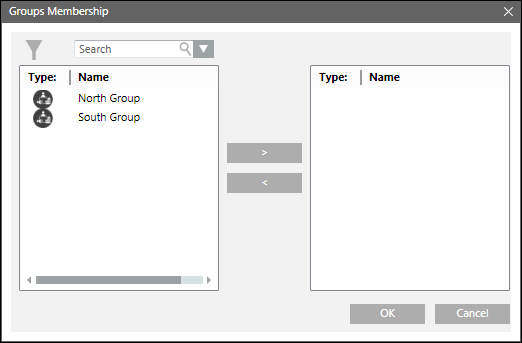
- Select the recipients to be associated with the group and click Move
 to move the selection to the text box on the left.
to move the selection to the text box on the left.
NOTE 1: Add a maximum of 1000 recipients to a recipient group.
NOTE 2: Click Filter to narrow the search based on the recipient type. Refer to steps 6 and 7 in the Updating a Recipient Group section for detailed instructions.
to narrow the search based on the recipient type. Refer to steps 6 and 7 in the Updating a Recipient Group section for detailed instructions.
- Click OK.
- The Members list is updated with the selected recipients.
- Select Groups Membership and click Add.
NOTE 1: Refer a group to another group to build larger structures. However, it is not possible to have recursive groups where groups refer to each other.
NOTE 2: For detailed instructions on groups membership, see Create/Import Recipient User OR Create Recipient Devices.
- Click Save
 .
.
- The recipient group is created.
Update a Recipient Group
- The recipient groups are created.
- Select Applications > Notification > Recipients.
- The Recipients Editor tab displays.
- Open the Recipients expander.
- The list of recipients displays.
- Select the recipient group to be updated.
- The details displays.
- Select General and update the Name.
- Select Members, click Filter
 to select the recipient type to be viewed.
to select the recipient type to be viewed.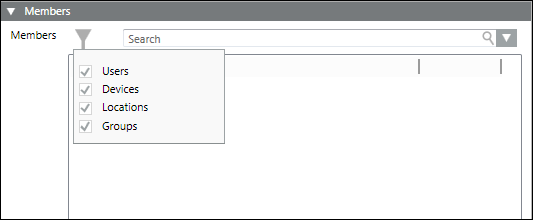
- (Optional) Enter a keyword in the Search field.
- (Optional) To add a recipient to a group, do the following:
a. Click Add: The Group Membership dialog box displays.
b. Select the recipient and click Move to move the selection to the text box on the left.
to move the selection to the text box on the left.
c. Click OK.
- (Optional) To remove a recipient from the group, select the required recipient from the Members list and click Remove.
- (Optional) To add the group to other recipient groups, do the following:
a. Select Groups Membership.
b. Click Add: The Group Membership dialog box displays.
c. Select the group to which you want to add this group.
d. Click Move to move the selection to the text box on the left.
to move the selection to the text box on the left.
e. Click OK.
- (Optional) To remove the group from another recipient group, select the recipient group and click Remove.
- Click Save
 .
.
- The recipient group is saved with the updated details.
Delete a Recipient Group
- The recipient groups are created.
- Select Applications > Notification > Recipients.
- The Recipients Editor tab displays.
- Open the Recipients expander.
- The list of recipients displays.
- Select the Recipient Group to be deleted.
- Click Remove
 .
.
- A confirmation message displays.
- Click Yes.
- The recipient group is deleted.
This section describes additional recipient device-related procedures.
Update/Delete a Recipient Device
- The recipient devices are created.
- Select Applications > Notification > Recipients.
- The Recipients Editor displays.
- Open the Recipients expander.
- The list of recipients displays.
- Select the Recipient Device to be updated or deleted.
- (Optional) To update the recipient device, do the following:
a. Select Groups Membership and click Add: The Group Membership dialog box displays.
b. Select the group to which you want to add this recipient device and click Move to move the selection to the text box on the left.
to move the selection to the text box on the left.
c. Click OK.
- (Optional) To remove the recipient device from a recipient group, do the following:
a. Select the recipient group and click Remove.
b. Click Save .
.
- (Optional) To delete the recipient device, do the following:
a. Click Remove : A confirmation message displays.
: A confirmation message displays.
b. Click Yes.
- The recipient device is saved with the updated details.
- The recipient device is deleted.
NOTE: The deleted recipient devices will still show up for already existing notifications but will be removed from all notification templates.
This section describes process of creating, updating and deleting recipient location procedures.
Create Recipient Locations
- The locations are created. (Locations are referred to as aggregators on the management station. Refer to the Views chapter of Desigo CC.)
- Select Applications > Notification > Recipients.
- The Recipient Editor tab displays.
- Open the Recipients expander.
- In the System Browser, select the view that has the locations to be added as recipients.
- The location displays in the System Browser.
- Navigate to the required location and drag to the Recipients list.
- The location is added to the list.
- Select General > Location, the recipient location name displays by default.
- Select Groups Membership and click Add.
- The Group Membership dialog box displays.
- Select the group to which you want to add this recipient location as a member.
- Click Move
 to move the selection to the text box on the left.
to move the selection to the text box on the left.
- Click OK.
- Click Save
 .
.
- The recipient location is saved.
Update/Delete a Recipient Location
- The recipient locations are created.
- Select Applications > Notification > Recipients.
- The Recipients Editor tab displays.
- Open the Recipients expander.
- Select the recipient location to be updated/ deleted.
- To update a recipient location, do the following:
a. Select Groups Membership.
b. Click Add to add the recipient location to a recipient group: The Group Membership dialog box displays.
c. Select the group to which you want to add this recipient location as a member.
d. Click Move to move the selection to the text box on the left.
to move the selection to the text box on the left.
e. Click OK.
- (Optional) To remove the recipient location from a recipient group, do the following:
a. Select the recipient group and click Remove.
b. Click Save .
.
- (Optional) To delete a recipient location, do the following:
a. Click Remove : A confirmation message displays.
: A confirmation message displays.
b. Click Yes.
- The recipient location is saved with the updated details.
- The recipient location is deleted.
This section describes process of creating, updating and deleting the contact list.

NOTE:
The contact list is available only for Reno Plus and MNS license users.
Create Contact List
- Select Applications > Notification > Recipients.
- The Recipients Editor tab displays.
- Open the Recipients expander.
- Click Contact List
 .
.
- The contact list is added to the list of recipients.
- Select General, the name displays as Contact List by default.
- Select Members and click Add to add recipients to the contact list.
- The Groups Membership dialog box displays.
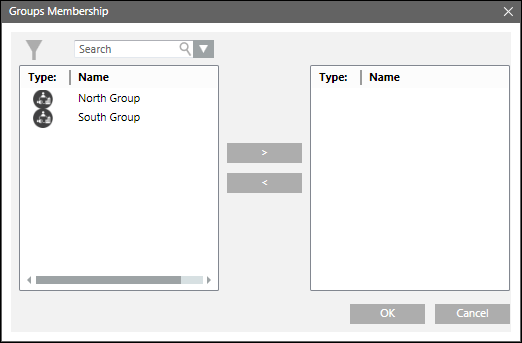
- Select the recipients to be added to the contact list and click
 to move the selection to the text box on the left.
to move the selection to the text box on the left.
- Click OK.
- The Members list is updated with the selected recipients.
- Click Save
 .
.
- The contact list is saved.

NOTE 1:
Create only one contact list.
NOTE 2:
Multiple recipient groups can be associated under one contact list but cannot add a contact list to any recipient groups.
Update/Delete a Contact List
- A contact list is created.
- Select Applications > Notification > Recipients.
- The Recipients Editor tab displays.
- Open the Recipients expander.
- The Recipients list displays.
- Select the contact list to be updated or deleted.
- To update a contact list, do the following:
a. Select Members.
b. Click Add to add more recipients to the contact list: The Groups Membership dialog box displays.
c. Select the recipients to be added to the contact list and click to move the selection to the text box on the left.
to move the selection to the text box on the left.
d. Click OK: The Members list is updated with the selected recipients.
- (Optional) To remove a recipient from the contact list, do the following:
a. Select the required recipient.
b. Click Remove.
c. Click Save : The contact list is saved with the updated details.
: The contact list is saved with the updated details.
- To delete a contact list, do the following:
a. Click Remove : A confirmation message displays.
: A confirmation message displays.
b. Click Yes.
- The contact list is saved with the updated details.
- The contact list is deleted.
This section describes the process for updating, and deleting recipient user device types and their corresponding modalities.
Update a Recipient User Device Type and Delivery Method
- Select Applications > Notification > Recipients.
- The Recipients Editor tab displays.
- Open the User Device Types expander.
- Under Device Types, select the user device type and update the required fields.
- Under Delivering Methods, select the delivery method and update the required fields.
- Click Save
 .
.
- The user device type and delivering method are updated.
Remove a Recipient User Device Type and Delivery Method
- Select Applications > Notification > Recipients.
- The Recipients Editor tab displays.
- Open the User Device Types expander.
- Under Device Types, the list of default user device types displays.
- To remove a recipient user device type, do the following:
a. Under User Types, select the user device type to be removed.
b. Click Remove: A confirmation message displays.
c. Click Yes: The selected device type is removed.
- To remove a delivering method, do the following:
a. Under Delivering Methods, select the delivering method to be removed from the list.
b. Click Remove.
c. A confirmation message displays.
d. Click Yes: The selected delivery method is removed.
- Click Save
 .
.
- The settings are saved.
This section describes additional recipient user languages related procedures.
Update/Remove a Recipient User Language
- Select Applications > Notification > Recipients.
- The Recipients Editor tab displays.
- Open the Recipient Languages expander.
- The recipient languages list displays.
- Click the recipient language to be updated/deleted.
- To update the recipient user language, do the following:
- Edit the name.
- Select the desired Culture for the language from the drop-down list.
- (Available only for MNS license users) Select a speech voice for the recipient language from the Speech voice drop-down list.
- To delete the recipient user language, do the following:
- Select the language to be removed.
- Click Remove: A confirmation message displays.
- Click Yes.
- The selected language is removed.
- Click Save
 .
.
- The updates are saved.
This feature is available only for MNS license users.
Notification can convert textual content to audible content and play that content on audio-only devices. Each recipient language that supported by Notification requires the installation of a text-to-speech engine to ensure proper pronunciation in that language.
Notification is tested and confirmed to work with voices from the following vendors:
- Acapela
- NeoSpeech
Refer to the text-to-speech installation manual of the vendor for details on installing its corresponding text-to-speech engine.
The table below lists the recommended voices for the supported languages:
Language | Recommended Voice |
English | VW Paul |
French | Louise |
German | Klaus |
In addition to the recommended voices, other voices from the installed vendor can be used with Notification. For more information, refer to Installing New Voices.
The speech voice can be configured for all recipient languages.
Install New Voices
- The voices to be installed are either an x64 bit version or compatible with x64 bit programs.
- The voices are SAPI compliant and compatible with .NET 4.0, specifically with Speech Synthesizer for .NET 4.0.
- Refer to the text-to-speech installation manual of the vendor for details on installing more voices.
- Open the SAPI user Interface (UI) from C:\Windows\System32\Speech\SpeechUX\sapi.cpl.
- The installed voices are displayed in the Voice selection drop-down list in the Text to Speech tab of the Speech Properties dialog box.
NOTE: If Notification was running during installation of a voice, the project in the System Management Console (SMC) must be restarted to view the voices in the Notification UI.
Configure a Speech Voice for Recipient Language
- Select Applications > Notification > Recipients.
- The Recipients Editor tab displays.
- Open the Recipient Languages expander.
- The list of available recipient languages displays.
- To set the speech for a language, select the language and click Speech voice.
- Select the required speech from the drop-down list.
- Click Save
 .
.
- The speech is configured for the selected language.
This section contains procedures for importing recipients.
Import Recipients from XML
The import feature is disabled for Web client and Windows App client.
- Select Applications > Notification > Recipients.
- The Recipients Editor tab displays.
- Select the Import tab.
- Select the Import from XML expander, click Browse.
- The Open dialog box displays.
- Select the location where the xml file is stored.
- Select the xml file.
- Click Open.
- The path of the xml file displays in the Import file field.
- Click Import.
NOTE: XML format is meant for system to system import of recipients. The selected xml file is imported.
Import Recipients from XML using Command
- Select Applications > Notification > Recipients.
- The Recipients Editor tab displays.
- Select the Extended Operation tab.
- Click Import XML to enable the import options.
- In the File Path field, enter the local XML file path of the server.
- Click Send.
- The XML file specified in the file path is imported.
Import Recipients from XML using Reactions
- Select Applications > Logics > Reactions.
- The Reaction Editor tab displays.
- Drag the Recipients node from Applications > Notification > Recipients onto the Action expander of the Output expander.
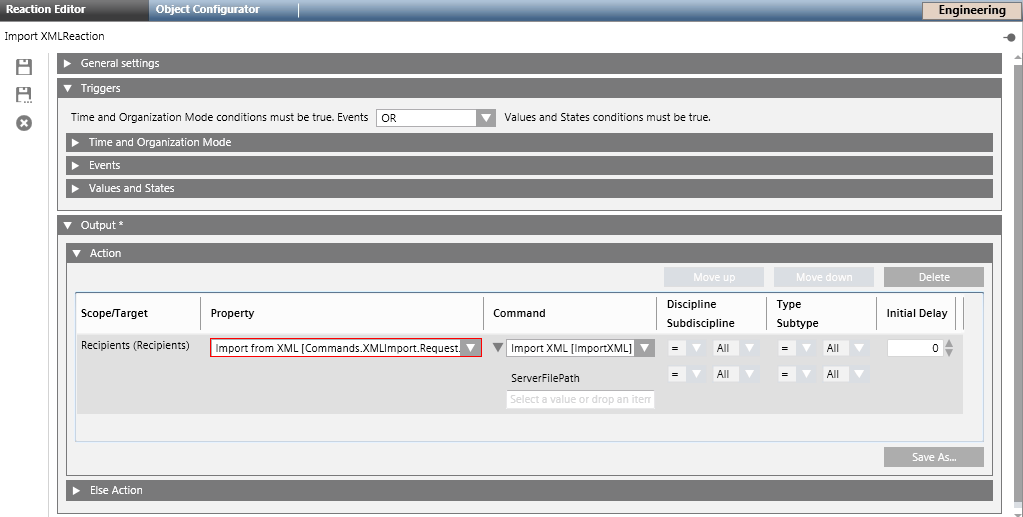
- From the Property drop-down list, select Import XML[Commands.XMLImport.Request.Import].
- Select the ImportXML[ImportXML] command to execute.
- In the ServerFilePath field, enter the local XML file path of the MNS server.
- Open the Triggers expander, and from the drop-down list, select the appropriate logical operator (AND, OR).
- Open the Time and Organization mode expander.
- Click Add to add a new time row and enter a new time or schedule that periodically triggers the Import XML command.
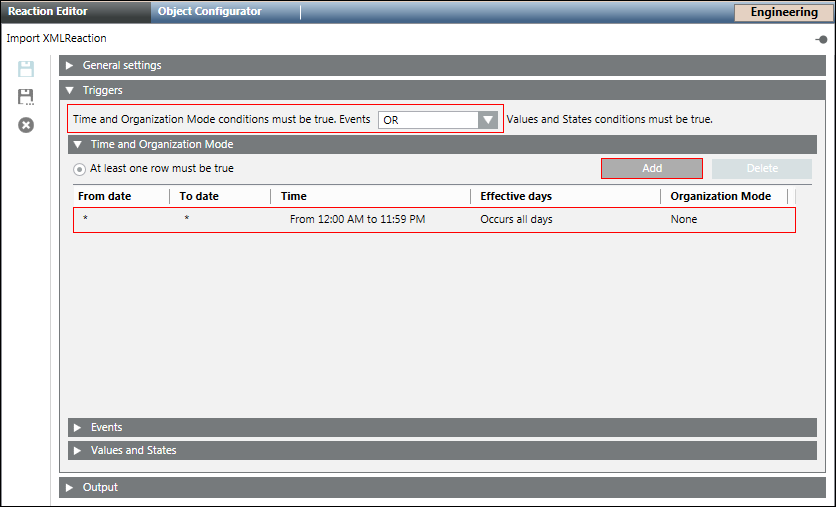
- Click Save As and enter the name and description for the Import XML reaction.
- The new Import XML reaction displays in the System Browser.
Configure Mappings for CSV Import
Before configuring the CSV mapping, the user first needs to determine three properties of the CSV files that the user is importing:
- Header row: The first row in a CSV file may contain column names. If a header row is present, columns can be referenced by name in the CSV mapping. Otherwise, columns will need to be referenced by their index (position) in the CSV file.
- Delimiter: A certain character that delimits two values in a CSV file. Notification supports commas, semicolons, spaces and tabs as delimiter.
- Quotation mark: Surrounding individual values with quotation marks allows the use of delimiter characters within values. Notification supports single quotes and double quotes as quotation marks.
NOTE 1:
CSV files exported from Excel by default have the following properties:
Header row: Yes
Delimiter: Comma
Quotation mark: Double quote.
NOTE 2:
If the character used as quotation mark appears within quoted values, the character must be escaped by doubling the corresponding character. This escaping process is typically performed by the process that creates a CSV file from a data source.

- Do the following to create a new import mapping:
a. Click New: The Create mapping as dialog box displays.
b. Enter a name for mapping in the Create mapping as dialog box.
c. Click OK: The Mapping field is populated with the name specified for the mapping.
d. Select the Header row check box if the user want to specify a title for the CSV file.
e. Select a separator from the Delimiter drop-down list.
f. In the Columns section, map a CSV Column with a notification property. For mapping, select a CSV column option from the CSV Column drop-down list and select a notification property for the corresponding CSV Column option from the Notification Property drop-down list. For example, Column 1(A) of CSV Column can be mapped to First Name of the Notification Property. You can correlate the alphabet A from the mapping column with the Microsoft Excel column header A, if Microsoft Excel is used to view the CSV file. Also, assign an individual recipient to the recipient group. To do this, select the appropriate CSV column from the CSV Column drop-down list and map to the recipient group from the Notification Property drop-down list.
NOTE 1: The recipient group to be used during import of CSV file must be first created in theNotification.
NOTE 2: The individual recipient will not be assigned to the recipient group if the corresponding value of the group in the CSV is either of the given values— "", " ", "0", "NO", or "FALSE". For values other than those mentioned above, the individual recipient will be assigned to the recipient group.
g. Select a quotation type from the Quotations drop-down list.
h. Click Save.
- The mapping is configured.
NOTE: This configured mapping can be saved for future use.
- Do the following to edit an existing mapping:
a. From the Mapping drop-down list, select the mapping.
b. Edit the required fields.
c. Click Save.
- To select an existing mapping, select it from the Mapping drop-down list.
- Do the following for saving an existing mapping under a new name:
a. Select the mapping from the Mapping drop-down list.
b. Click Save as: The Save mapping as dialog box displays.
NOTE: By default, Copy of [Mapping Name] displays in the Save mapping as dialog box.
c. Enter a new name for the corresponding mapping.
d. Click OK.
e. Click Save.
Import Recipients from CSV
- Select Applications > Notification > Recipients.
- The Recipients Editor tab displays.
- Select the Import tab.
- Open the Import from CSV expander.
- Click Browse.
- The Open dialog box displays.
- Select the location where the CSV file is stored.
- Select the CSV file.
- Click Open.
- The path of the CSV file displays in the Import file field.
- Select the Delete absent recipients check box to delete the recipients in the Notification that are not present in the CSV file.
NOTE 1: Recipients created manually through the recipient UI will never be deleted during CSV import.
NOTE 2: The mapping name is used as one of the criteria to delete recipient users hence when user deletes the mapping, a warning message displays.
- Click Import.
- The selected CSV file is imported.
NOTE: If imported recipient users need to be updateable through subsequent imports, the Unique ID property under the Notification property needs to be mapped to a CSV column that contains values that uniquely identify recipient users, like an employee ID.
Import Recipients from CSV using Command
- Select Applications > Notification > Recipients.
- The Recipients Editor tab displays.
- Select the Extended Operation tab.
- Click the Import CSV link to enable the import options.
- The Delete Users, Mapping, File Path fields and Send displays.
- Select the appropriate value (Yes or No) from the Delete Users check box.
- Enter the mapping to be used for the CSV import in the Mapping field.
- In the File Path field, enter the local CSV file path of the MNS server.
- Click Send.
- The CSV file specified in the file path is imported.
Import Recipients from CSV using Reaction
- Select Applications > Logics > Reactions.
- The Reaction Editor tab displays.
- Drag the Recipients node from Applications > Notification > Recipients onto the Action expander of the Output expander.
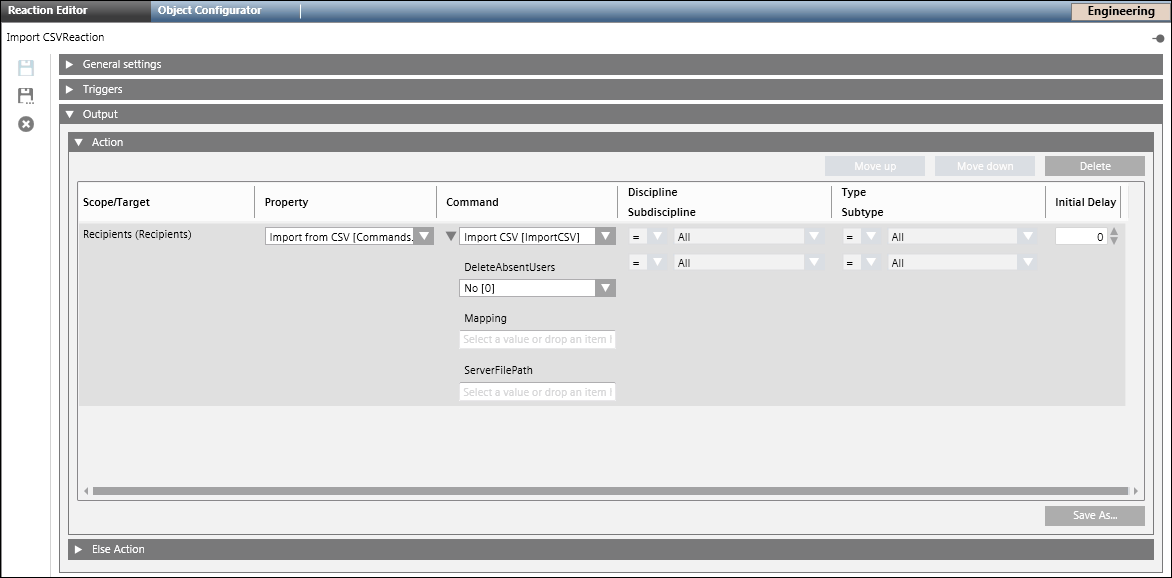
- Select Import CSV[Commands.CSVImport.Request.Import] from the Property drop-down list.
- Select ImportCSV[ImportCSV] command to execute.
- Select the appropriate value (Yes or No) from the DeleteAbsentUsers list box.
- Enter the mapping to be used for the CSV import in the Mapping field.
- In the ServerFilePath field, enter the local CSV file path of the MNS server.
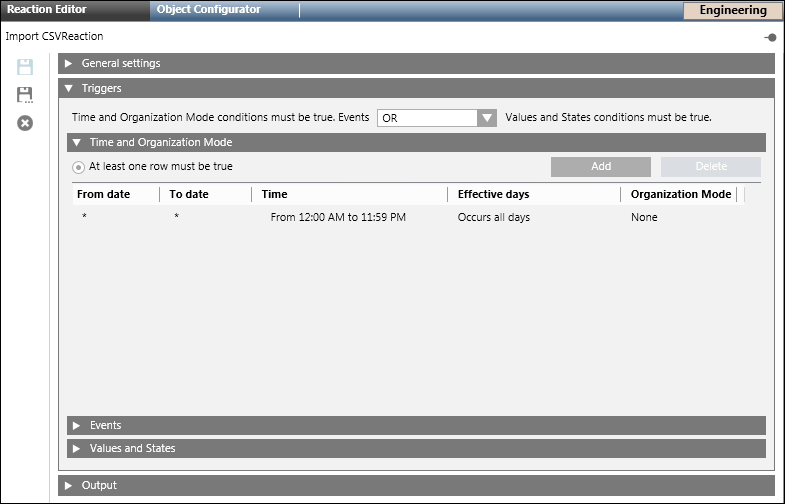
- Open the Triggers expander.
- From the drop-down list, select the appropriate logical operator (AND, OR).
- Open Time and Organization Mode expander.
- Click Add to add a new time row and enter a new time or schedule that periodically triggers the Import CSV command.
- Click Save As and enter the name and description for the Import CSV Reaction.
- The new Import CSV Reaction displays in the System Browser.
Configure Mappings for an Active Directory Import
- To create a new import mapping, click New.
- In the Create mapping as dialog box that displays, enter a name for mapping and click OK.
- The Mapping field is populated with the name specified for the mapping.
- In the Columns section, map an Active Directory property with a Notification property by either selecting an Active Directory property from the drop-down list or by entering an Active Directory property manually in the Active Directory Property field. For example, First name of the Active Directory Property can be mapped to First Name of Notification Property.
NOTE: Each Active Directory property has a real name and a display name, for example, givenName is the real name of an Active Directory property with display name as First name. The properties listed in the Active Directory Property drop-down list are the display names of the real Active Directory properties. If user wants to use any property not listed in the drop-down list then type the real name of the Active Directory property. In order to get the real name of the Active Directory property, a tool which shows real Active Directory property name and its display name must be used, for example, Remote Server Administration Tools for Windows 7.
- Click Save.
NOTE: An error message displays if there are invalid entries in the Active Directory properties mapping. In such scenarios, click OK. Rectify the error and click Save.
- The mapping is configured.
- Do the following for editing an existing mapping:
a. Select the mapping from the Mapping drop-down list.
b. Edit the required fields.
c. Click Save.
- To select an existing mapping, select it from the Mapping drop-down list.
- Do the following for saving an existing mapping under a new name:
a. Select the mapping from the Mapping drop-down list.
b. Click Save As: The Save mapping as dialog box displays.
NOTE: By default, Copy of [Mapping Name] displays in the Save mapping as dialog box.
c. Enter a new name for the corresponding mapping.
d. Click OK.
e. Click Save.
Import Recipients from Active Directory
- Select Applications > Notification > Recipients.
- The Recipients Editor tab displays.
- Select the Import tab.
- Open the Import from Active Directory expander.
- Enter the Active Directory server's address in the Server field.
- Click Connect.
- The list of the departments available in the corresponding Active Directory displays in the Available departments section.
- Select the departments to be imported.
NOTE: Search for the department by typing in the department’s name in the Search field.
- For importing departments, select an individual department from the Available departments section and click
 to move the department to the Departments to import section.
to move the department to the Departments to import section.
- To move departments from the Departments to import section to the Available departments section, select an individual department from the Departments to import section and click
 to move the department to the Available departments section.
to move the department to the Available departments section.
- Select the Delete absent recipients check box to delete the recipients in the Notification that are not present in the Active Directory.
NOTE 1: Recipients created manually through the recipient UI will never be deleted during Active Directory import.
NOTE 2: The mapping name is used as one of the criteria to delete recipient users hence when user deletes the mapping, a warning message displays.
- Click Import.
- The selected departments are imported.

NOTE:
If imported recipient users need to be updateable through subsequent imports, the Unique ID property under Notification Property needs to be mapped to an Active Directory Property that contains values that uniquely identify recipient users, like an employee ID.
Import Recipients from Active Directory using Command
- Select Applications > Notification > Recipients.
- The Recipients Editor tab displays.
- Select the Extended Operation tab.
- Click the Import AD link to enable the import options.
- The AD Server, Delete Users, Departments, Mapping fields and Send button display.
- Enter the Active Directory server address in the AD Server field.
- Select the appropriate value (Yes or No) from the Delete Users list to delete recipients from Notification that are not present in the Active Directory.
- Enter the department name to import. Multiple department names can be entered by using the comma separator.
- Enter the mapping to be used for importing the Active Directory in the Mapping field.
- Click Send.
- The selected departments are imported.
Import Recipients from Active Directory using Reaction
- Select Applications > Logics > Reactions.
- The Reaction Editor tab displays.
- Drag the Recipients node from Applications > Notification > Recipients onto the Action expander of the Output expander.
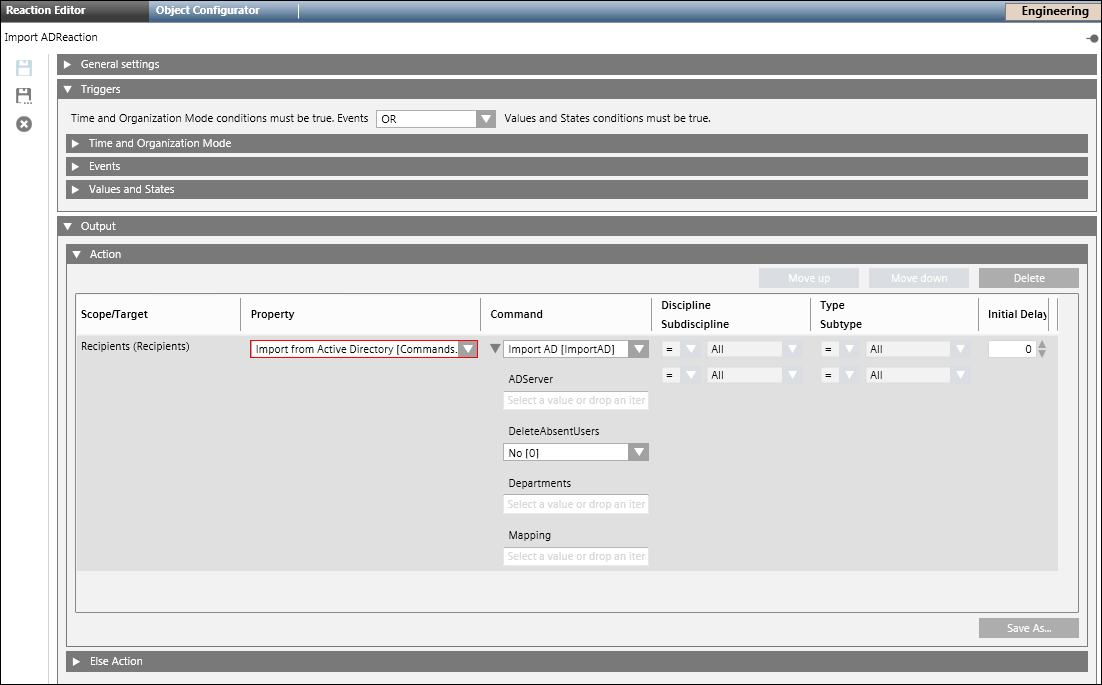
- Select Import from Active Directory[Commands.ADImport.Request.Import] from the Property drop-down list.
- In the ADServer field, enter the server address of the Active Directory to import.
- Select the appropriate value (Yes, No) from the DeleteAbsentUsers list box.
- In the Departments field, enter the department name.
NOTE: Multiple department names can be entered by using a comma separator.
- In the Mapping field, enter the mapping to be used for the AD import.
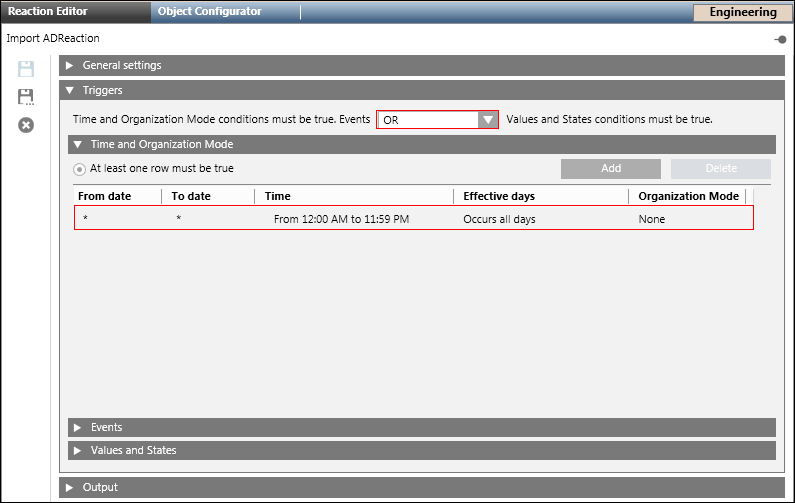
- Open the Triggers expander. From the drop-down list, select the appropriate logical operator (AND, OR).
- Open the Time and Organization Mode expander.
- Click Add to add a new time row and enter a new time or schedule that periodically triggers the Import From Active Directory command.
- Click Save As and enter the name and description for the Import Active Directory Reaction.
- The new Import Active Directory Reaction displays in System Browser.
Delete a CSV Mapping
- One or more CSV mappings are present.
- Select the mapping from the Mapping drop-down list.
- Click Delete.
- The selected mapping is deleted.
Delete an Active Directory Mapping
- One or more Active Directory mappings are present.
- Select the mapping from the Mapping drop-down list.
- Click Delete.
- The selected mapping is deleted.
This section describes additional procedures exporting recipients.
Export Recipients to XML
The Export feature is disabled for Windows App client.
- Select Application > Notification > Recipients.
- The Recipients Editor tab displays.
- Select the Export tab.
- Open the Export to XML expander.
- Select the recipients to be exported and click
 to move the selection to the Selected for export text box.
to move the selection to the Selected for export text box.
NOTE: Search recipients to narrow down the list by typing in the recipient name.
- Click Export.
- The Save dialog box displays.
- Select the location where the XML file must be saved.
- Enter a file name.
- Click Save.
NOTE: XML format is meant for system to system export of recipients.
- The recipients are exported in XML format.
Export Recipients to XML using Command
- Select Applications > Notification > Recipients.
- Click the Export XML link.
- The Recipients Editor tab displays.
- Select the Extended Operation tab.
- Click the Export XML link to enable the export options.
- The File Path field and Send display.
- In the File Path field, enter the local file path of the MNS server where the XML file must be saved.
- Click Send.
- All the recipients in the Notification are exported to the XML file specified in the file path.
Export Recipients to XML using Reaction
- Select Applications > Logics > Reactions.
- The Reaction Editor tab displays.
- Drag the recipients node from Applications > Notification > Recipients onto the Action expander of the Output expander.
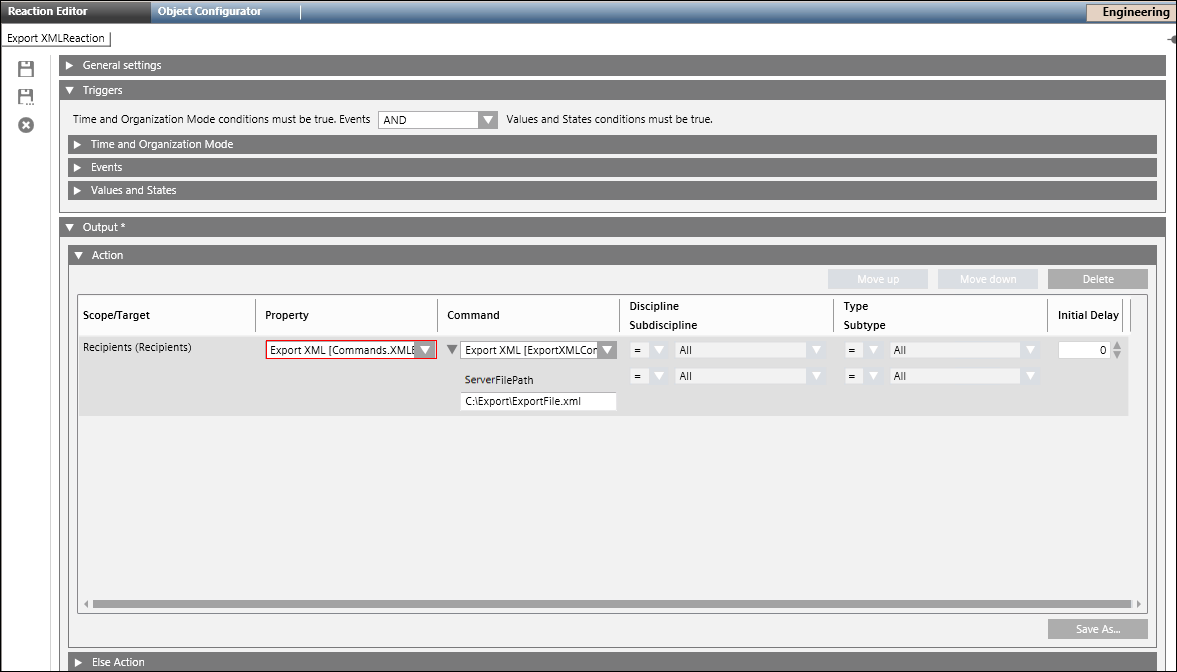
- Select Export XML[Commands.XMLExport.Request.Export] from the Property drop-down list.
- Select ExportXML[ExportXML] command to execute.
- In the ServerFilePath field, enter the local file path of the MNS server where the XML file must be saved.
- Open the Triggers expander. From the drop-down list, select the appropriate logical operator (AND, OR).
- Open the Time and Organization Mode expander.
- Click Add to add a new time row and enter a new time or schedule that periodically triggers the Export XML command.
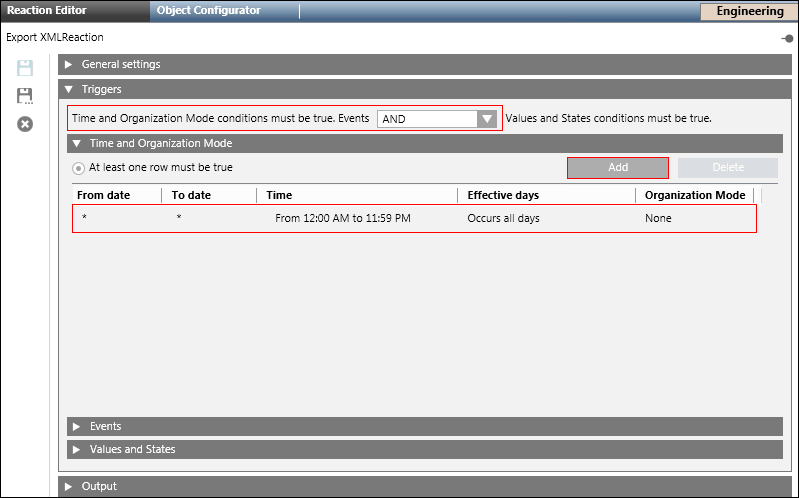
- Click Save As and enter the name and description for the Export XML reaction.
- The new Export XML reaction displays in the System Browser.
Configure Mappings for CSV Export
Before configuring the CSV mapping, the user first needs to determine three properties of the CSV files:
- Header row: The first row in a CSV file may contain column names. If a header row is present, columns can be referenced by name in the CSV mapping. Otherwise, columns will need to be referenced by their index (position) in the CSV file.
- Delimiter: A certain character that delimits two values in a CSV file. Notification supports commas, semicolons, spaces and tabs as delimiter.
- Quotation mark: Surrounding individual values with quotation marks allows the use of delimiter characters within values. Notification supports single quotes and double quotes as quotation marks.
NOTE 1: CSV files exported from Excel by default have the following properties:
Header row: Yes
Delimiter: Comma
Quotation mark: Double quote.
NOTE 2: If the character used as quotation mark appears within quoted values, the character must be escaped by doubling it. This escaping process is typically performed by the process that creates a CSV file from a data source.

- Do the following to create a new export mapping:
a. Click New: The Create mapping as dialog box displays.
b. Enter a name for the mapping and click OK: The name displays under Mapping.
c. (Optional) Select the Header row check box if the exported CSV file must contain a header row.
d. Select a separator from the Delimiter drop-down list.
e. In the Columns section, map a Notification Property with a CSV Column. From the Notification Property drop-down list, select a Notification property and enter a CSV column option for the corresponding Notification property in the CSV column drop-down list.
f. From the Quotations drop-down list, select a quotation type.
g. Click Save.
- The mapping configuration is saved.
NOTE: This configured mapping can be saved for future use.
- Do the following to edit an existing mapping:
a. Select the mapping from the Mapping drop-down list.
b. Edit the required fields.
c. Click Save.
- To select an existing mapping, select it from the Mapping drop-down list.
- Do the following to save an existing mapping under a new name:
a. Select the mapping from the Mapping drop-down list.
b. Click Save As.
c. The Save mapping as dialog box displays.
NOTE: By default, Copy of [Mapping Name] displays in the Save mapping as dialog box.
d. Enter a new name for the corresponding mapping.
e. Click OK.
- Click Save.
Export Recipients to CSV
- Select Application > Notification > Recipients.
- The Recipients Editor tab displays.
- Select the Export tab.
- Expand Export to CSV and select the recipients to be exported and click
 to move the selection to the Selected for export text box.
to move the selection to the Selected for export text box.
NOTE: Search recipients to narrow down the list by typing in the recipient name.
- Select a mapping configuration if present or create a mapping configuration. Refer to the Configuring Mappings for CSV Export section for more information.
- Click Export.
- The Save dialog box displays.
- Select the location where the CSV file must be saved.
- Enter a file name and click Save.
- The recipients are exported in CSV format.
Export Recipients to CSV using Command
- Select Applications > Notification > Recipients.
- The Recipients Editor tab displays.
- Select the Extended Operation tab.
- Click the Export CSV link to enable the export options.
- The Mapping, File Path field and Send button display.
- Enter the mapping to be used for the CSV export in the Mapping field.
- Select the File Path field, enter the local file path of the MNS server where the CSV file must be saved.
- Click Send.
- The recipients are exported in CSV format.
Export Recipients to CSV using Reaction
- Select Applications > Logics > Reactions.
- The Reaction Editor tab displays.
- Drag the recipients node from Applications > Notification > Recipients onto the Action expander of the Output expander.
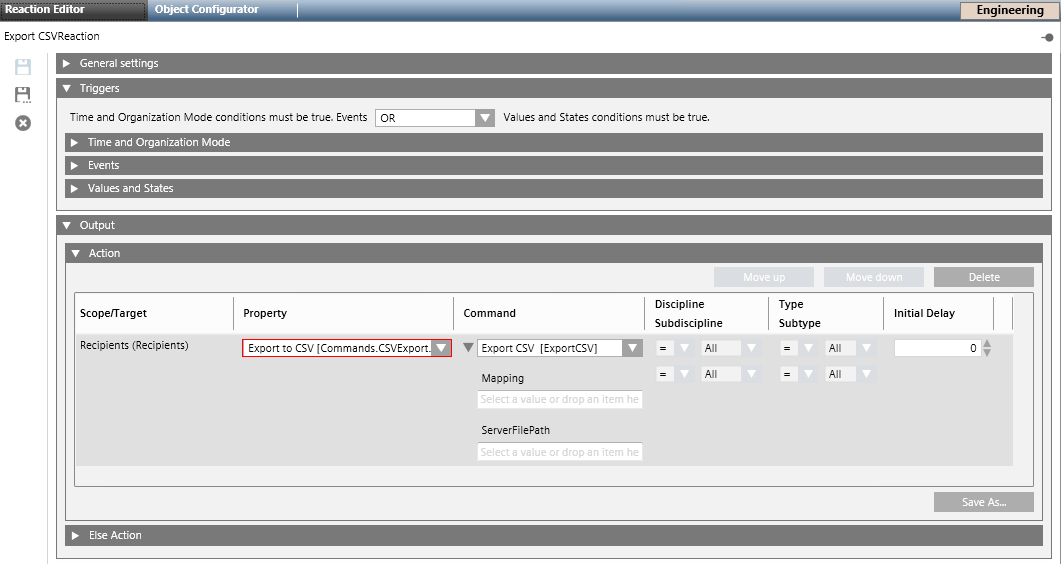
- From the Property drop-down list, select Export to CSV [Commands.CSVExport.Request.Export].
- The ExportCSV[ExportCSV] command displays under Command column.
- Enter the mapping to be used for the CSV export in the Mapping field.
- In the ServerFilePath field, enter the local file path of the MNS server where the CSV file must be saved.
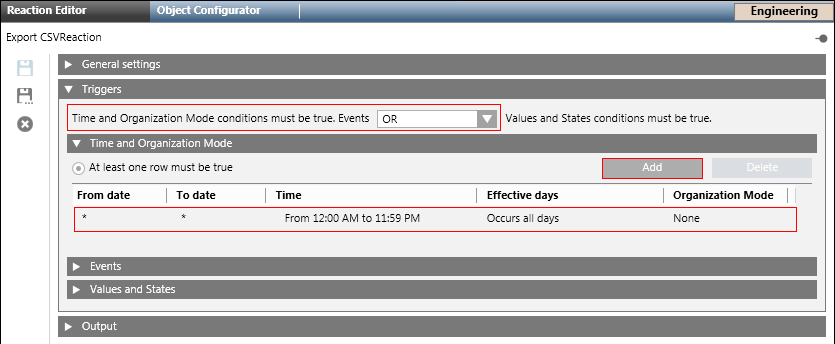
- Open the Triggers expander.
- From the drop-down list, select the appropriate logical operator (AND, OR).
- Open the Time and Organization Mode expander.
- Click Add to add a new time row and enter a new time or schedule that periodically triggers the export to CSV command.
- Click Save As and enter the name and description for the export to CSV reaction.
- The new export to CSV reaction displays in the System Browser.
This procedure is available only for MNS license users.
- One Media Controller device is available to recipients.
- Media Files are imported to the Media Library.
- System Manager is in Engineering mode.
- In System Browser, select Application View.
- Select Applications > Notification > Recipients.
- Select the Media Controller tab.
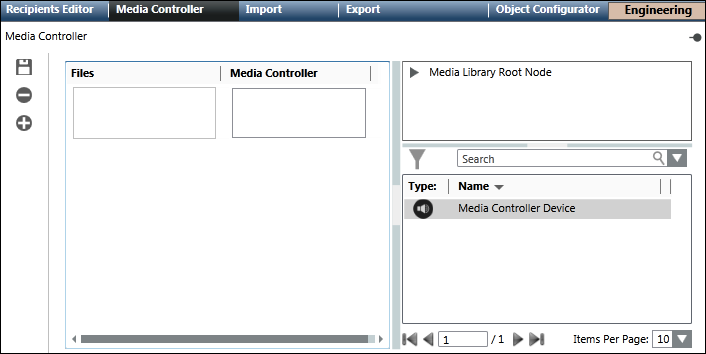
- Click Add new item
 .
.
- Select the Media Library Root Node.
- Select the Folder Node.
- Drag the media file to the Files field.
- Drag the Media Controller device, displayed in the dialog box below the Media Library root node, to the Media Controller field.
- Click Save
 .
.
- Select Applications > Notification.
- Select the Extended Operation tab.
- Click Preload.
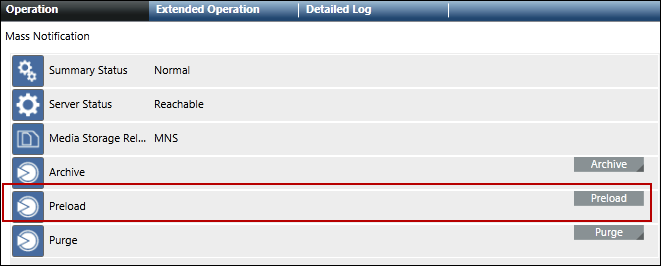
- A success message displays.
